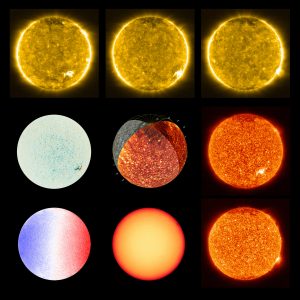
The many faces of the Sun from Solar Orbiter’s EUI and PHI instruments. Image credit: Solar Orbiter/EUI Team; PHI Team/ESA & NASA
In astronomy, the month of July has been the month of two things: comets, and Mars. Comet Neowise, or to give it it’s full title C/2020 F3 NEOWISE, has graced the skies of the northern hemispheres, becoming the first naked eye comet for some time. Some have even argued it’s the best comet for decades.
In terms of new missions, then this summer marks the best window to launch missions to Mars. These windows come around roughly every two years, or so, since that’s how long it takes for the Earth to line up with Mars’ position around its orbit. This launch window, no fewer than three countries are taking advantage of the opportunity: the United States with the Perseverance Rover, China with the Tianwen-1 orbiter and rover and the United Arab Emirates with the Hope mission.
But from missions to Mars to mission to the Sun. Back in February this year the European Space Agency launched the Solar Orbiter mission to study our star and try to answer some of the remaining mysteries. With the first set of initial images and results out, Professor Lucie Green, from the Mullard Space Science Laboratory, provides an update.
An extended edition of an original broadcast on 30th July 2020 as part of Pythagoras’ Trousers on Radio Cardiff.





